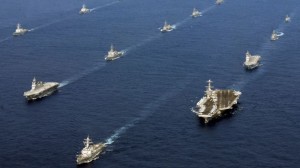2014-06-2 In a recent interview with the well-known China expert and Forbes columnist, Gordon Chang, Rear Admiral Manazir, the head of naval warfare, highlighted the importance of global partnerships to meet the challenges the military and security challenges facing the US in the 21st century.
As Chang put the basic proposition:

“In the tense settings of the future, the partnerships with allied navies will be force multipliers, taking the strain off America’s shrinking defense budgets.”
In the interview Rear Admiral Manazir drew upon his recent carrier command experience to highlight the role of global partnerships in shaping deterrence in depth capabilities.
Rear Admiral Michael Manazir made this point when he told me how in May of last year he stared down Iranian craft that wanted to interfere with the ships he commanded in international water in the Persian Gulf.
Yes, his vessels must have looked impressive to the Iranians, but what was even more fearsome was the multinational task force of which they were a part.
Manazir’s ships were but a few of the 35 vessels participating in the International Mine Countermeasures Exercise, a freedom of navigation drill that last year included 6,500 sailors and representatives from 41 nations.
There is nothing so frightening for the seamen of a rogue state than to see ships from a unified coalition on the high seas backed by history’s mightiest maritime force.
Gordon Chang went on in his article to describe how new technologies were on the way to enhance the capability of the USN-USMC team to work with allies and partners.
Manazir no longer sits high above a carrier deck in the Middle East fending off bandits in shallow waters.
He occupies a chair in the Pentagon as the Navy’s director of Air Warfare.
There he thinks about integrating vertical takeoff planes on surface combatants and getting the Gerald R. Ford, the first of its class of carriers, ready to join the fleet in two years.
The most important projects that cross his desk are the next generation of weapons being developed with other nations, most notably the F-35 Lighting II, a 5th-Generation fighter that will one day rule the skies over international water.
Britain’s Royal Navy is a development partner, and the fighter will be sold to various treaty allies and friends that have contributed to the program.
As a result of the joint efforts, the F-35B, the vertical takeoff version, and the F-35C, the carrier variant, will soon be deployed on our ships and those of our friends.
The sharing of the plane by navies around the world will, of course, enhance interoperability, giving U.S. admirals like Manazir better ability to meet maritime threats.
For the full article please go to the following:


